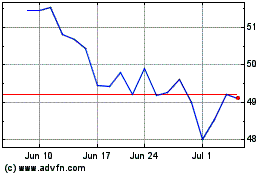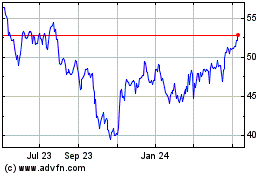IEA Chief Reiterates Forecast for $80 Oil
December 01 2015 - 3:10PM
Dow Jones News
NEW YORK—Oil prices will start climbing in 2017, rising to $80 a
barrel in coming years as production declines in some regions and
global demand continues to grow, the executive director of the
International Energy Agency said Tuesday.
Robust output in the U.S., Saudi Arabia and other countries has
resulted in a glut of crude, which has pushed oil prices down about
40% in the past year. U.S. and global prices are currently hovering
slightly above $40 a barrel.
Oil prices at $50 a barrel or lower are "not sustainable," said
Fatih Birol, head of the IEA, in an interview with The Wall Street
Journal. Mr. Birol's comments reiterate the agency's forecasts
released last month.
The Paris-based IEA expects production in nations outside the
Organization of the Petroleum Exporting Countries to drop by more
than 600,000 barrels a day in 2016, the largest decline since 1992,
as companies have sharply cut spending on new drilling.
Next year, prices are likely to remain under pressure from huge
commercial inventories of crude oil, which stood at a record high
of nearly three billion barrels at the end of September, the IEA
said in a report last month. That is roughly equivalent to a
month's worth of world-wide consumption.
"2016 will be a year where we will still have a lot of oil
around," Mr. Birol said. But "After that…we would expect to see
upward pressure on prices."
The past year's plunge in oil prices has rippled through the
global economy, providing a boon to drivers but hurting the
government revenues and currencies of large oil-producing nations.
Energy producers, facing anemic cash flow and tumbling stock
prices, have cut hundreds of thousands of jobs around the
world.
Mr. Birol's comments come ahead of OPEC's meeting in Vienna
later this week. The group of oil-producing nations opted last year
to keep its production high despite falling oil prices and is
currently producing above its target of 30 million barrels a day.
OPEC isn't expected to announce a change in strategy this week.
Market watchers expect increased Iranian crude exports to weigh
on oil prices next year if sanctions on the country are lifted. Mr.
Birol said Iran could increase its production by 500,000 barrels a
day within a year of sanctions being lifted, but beyond that the
country would need new investment to add to its output.
Global investment in new oil production fell by more than 20%
this year and will likely drop again next year, which would mark
the first time investment dropped for two straight years in at
least three decades, Mr. Birol said.
Current low oil prices pose dual threats to consuming nations,
he said.
First, the expected drop in non-OPEC production will make
consumers more dependent on Middle Eastern oil, and that supply
could be threatened due to violence in the region, Mr. Birol said.
Second, low prices could deter consuming countries from investing
in energy efficiency.
Write to Nicole Friedman at nicole.friedman@wsj.com
Subscribe to WSJ: http://online.wsj.com?mod=djnwires
(END) Dow Jones Newswires
December 01, 2015 14:55 ET (19:55 GMT)
Copyright (c) 2015 Dow Jones & Company, Inc.
Dominion Energy (NYSE:D)
Historical Stock Chart
From Mar 2024 to Apr 2024

Dominion Energy (NYSE:D)
Historical Stock Chart
From Apr 2023 to Apr 2024
